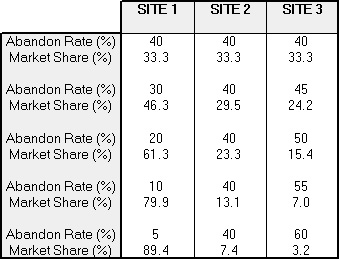The value of knowing customer behavior cannot be overstated. Knowing it, one can design a supply chain responsive to that behavior and dominate competitors.
Know your Customer Behavior
Here’s a simple eCommerce example :
Suppose shoppers come to your website or a competitor’s initially at random. Having shopped they go to check out and buy or abandon at a rate based on your freight payment policy. If they abandon your site they go to a competitor and don’t come back until they similarly abandon at another’s site. If they buy, you get that sale and, when ready, they come back to your site first–giving you another bite at the apple.
Knowing the abandonment rate in this market, you can determine the resulting market share of each competitor and all that those details entail – growth, top and bottom lines. Here are some examples in a three competitor market:
In addition to these numerical specifics this example reveals, there are several insights to be drawn :
- How customers behave while shopping and buying on your site and afterward matters a lot
- Competitors and what they do matter
- You have to perform against competitors or lose, perhaps big time
- Modest differences in abandonment rates can have large market share consequences
- Getting customers to come back to you and away from competitors is very effective.
DETERMINING HOW YOUR CUSTOMERS BEHAVE
Specifying exactly how customers behave is not a simple matter. However, the value of knowing it to some degree usually justifies the investment in trying to understand how customers make buying decisions.
Here are a few tips :
- If your customers buying behavior is complex, don’t try to discover it on the cheap–with inexpensive surveys that have highly structured questions, for example. Customers rarely put more effort into the survey than you do. Those that do respond to these surveys are a subset of all customers and therefor will bias the results in some way; usually in an unknown way
- Complex buying behavior can be discerned in face-to-face meetings that ask and probe about real past buying experiences…
- When did you last switch suppliers?
- Why did you switch?
- Why do you have multiple suppliers?
- Customers like to talk about what they do. Ask them in a business-like way and they’ll answer candidly
- Tap into your customers emotional buying behavior
WHAT NEXT?
Once you know your customers’ behavior you can simulate it. You can mimic customers buying from competitors, switching to others and simulate the churn that takes place in so many markets.
Chicago Consulting has a tool that performs this simulation. It quantifies the market shares of several competitors serving a market with a behavior selected from a menu. We provide this tool free to our clients.
Call us at (312) 346-5080 for your free copy.



